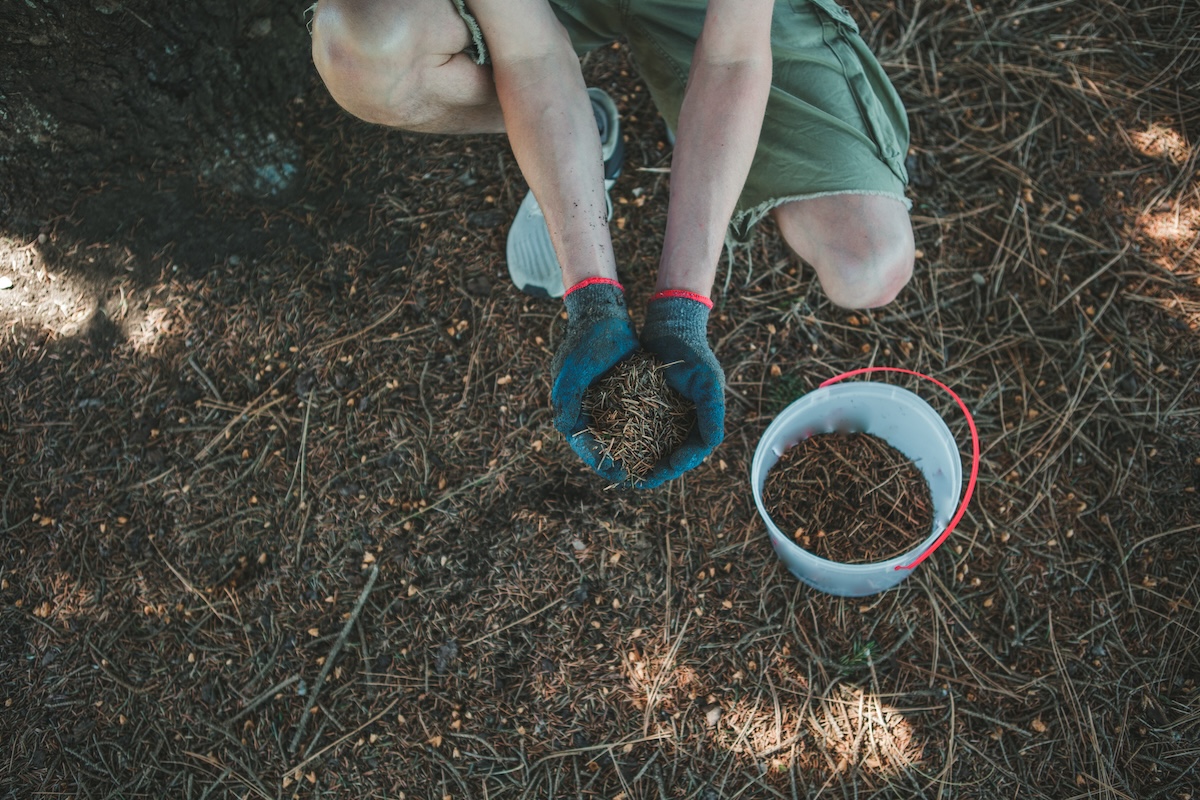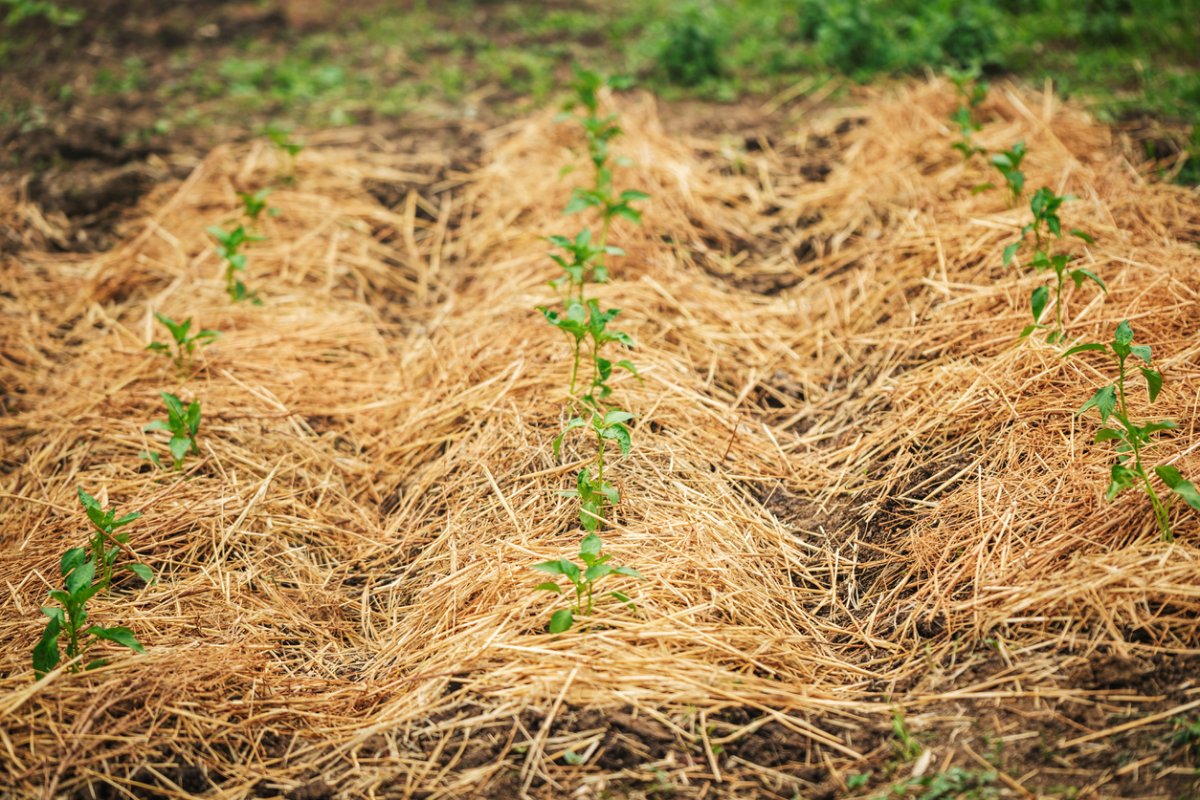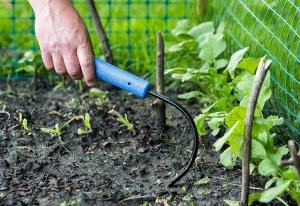

We may earn revenue from the products available on this page and participate in affiliate programs. Learn More ›
In some areas of the country, the choice between mulching with pine needles and wood mulch is a tough one. Since the 1980s, pine straw has been the favorite mulch in the South. It is inexpensive, effective, and attractive, especially in the vicinity of the ever-present loblolly and longleaf pines.
Like most mulches, pine needles contribute valuable organic matter to the soil, supporting an impressive diversity of native and ornamental landscape plants including trees, shrubs, perennials, and annuals. If you’re considering pine straw for your landscape, here are a few things you should know.
Advantages of Pine Straw Mulch

Using pine straw as mulch offers several benefits, especially in areas where the pine trees that drop their needles grow naturally. Consider these pros of pine straw in your garden beds.
1. Pine straw mulch weighs less than wood mulch.
Mulch weight might not be the first thing on your mind as you begin a spring landscape cleanup. But after loading up, unloading, and spreading a few bags, your arms and back might start asking questions. Wood mulch is deceivingly heavy, but pine straw can be deceptively lightweight.
The best way to compare the two is by taking a look at coverage per pound. A single bale of pine straw, which weighs about 35 pounds, covers about 50 square feet. Compare that to a standard 2-cubic-foot bag of wood mulch, which weighs about 25 pounds and covers 12 square feet. In general, pine straw covers close to 1.5 square feet per pound, while wood mulch covers about 0.5 square feet per pound. That’s one-third the weight per square foot of coverage, or three times the coverage per pound by pine straw.
2. Pine straw mulch can be sustainable.
The mulch pine straw that is sold in stores and landscape supply centers is harvested from timber farms. These privately held properties have a diverse set of goals, so measuring the environmental impact of the straw harvest is a complex undertaking that differs from one property to the next.
Still, homeowners who have loblolly or longleaf pine trees in their own yards can take advantage of fallen needles by reusing them to mulch the landscape, rather than bagging and disposing of the needles. It’s free mulch, and you only have to pick out the cones and sticks. This pine needle mulching is a more sustainable way to clear the driveway, lawn, and deck of needles while protecting and beautifying landscape beds.
3. Pine straw mulch is significantly less expensive than wood mulch.
To compare the cost of pine straw versus mulch, look again at the coverage per bag of mulch versus coverage per bale of pine straw. It’s pretty common to see 2-cubic-foot bags of wood mulch for sale at three for $10, or $3.33 each. Since each bag covers 12 square feet, that’s 36 square feet for $10, or 3.6 square feet per dollar.
At an average cost of about $4 per bale, and each bale covering about 50 square feet, pine straw comes in at 12.5 square feet per dollar. Buying pine straw for mulch instead of traditional wood mulch stretches a dollar nearly 3.5 times further. Using pine needles from your own trees saves even more.
4. Pine straw is an excellent insulator.
In addition to conserving moisture, preventing erosion, and helping to block weeds, pine straw mulch helps to keep the soil cool in summer; mulch can also keep soil warm in winter. Its loose structure creates trapped air space, like a blanket. The trapped air resists daily air temperature swings due to daytime and nighttime differentials, and warm or cold fronts passing through.
It takes long-term heat or cold due to seasonal changes to affect the soil temperature beneath the mulch layer. So, pine straw protects plant roots both in summer and in winter.
5. Pine needles maintain soil moisture well.
The same qualities that allow pine straw mulch to protect soil from temperature swings also help conserve soil moisture. Water perks into and evaporates out of soil through tiny pore-like channels. This well-defined structure is a sign of good soil health and also allows plants to establish deep root systems. If the soil surface is unprotected from the sun’s rays, it dries out quickly.
Using a layer of pine needles as mulch on the soil surface creates trapped air space that allows water to pass through into the soil. But because of their cooling effect, the needles greatly reduce moisture loss through evaporation.
6. Pine straw is less conducive to fungus.
In some parts of the country, pine straw’s acidic nature can create an inhospitable environment for some types of fungus that might otherwise wreak havoc on soil and plants. In addition, its airy nature that allows water through but the soil to breathe also can reduce conditions favorable to fungal growth.
Disadvantages of Pine Straw Mulch

Despite its advantages, pine straw might not be the right type of mulch for everybody or every garden. The lightweight needles can blow away in a heavy wind and aren’t as good at weed suppression as some mulches.
1. Pine straw mulch isn’t the best mulch option for preventing weeds.
While pine straw makes an excellent protective covering to maintain soil temperature, structure, and moisture levels, it does have a disadvantage. Compared with other types of mulch, pine needles used for landscaping do not smother weeds as well. Laying down pine straw as mulch allows some moisture and light to penetrate, which can encourage weed seed germination. It also makes a wonderful habitat for trailing perennials like Virginia creeper, Bermuda grass, poison ivy, and others to spread where they’re not wanted.
Control weeds in mulched areas by maintaining a 3-inch-deep layer of pine straw, applying weed preventer, pulling weeds before they go to seed, and by spraying liquid weed killer if necessary.
2. Pine straw mulch can be a fire hazard.
This mulch option is, unfortunately, highly flammable. It’s quick to ignite, and a fire in pine straw mulch spreads quickly, which can rapidly endanger nearby structures. It also burns at higher temperatures than other mulch types.
3. Pine straw can be slippery on a sloped landscape.
Even when dry, pine needles can be slippery. When wet, they’re extremely slippery. This can be hazardous not only on a sloped grade, but on a flat area as well.
4. It can blow away.
Lightweight pine straw mulch can blow away in heavy winds, which can thin the mulch layer and lessen its weed-preventing and soil-protection benefits. At the very least, needles are likely to blow out of your neat flower beds and onto your lawn, creating an untidy mess.
How to Buy Pine Straw
Shoppers may find two types of pine needles for mulch to choose from: Long-needle pine straw comes from the longleaf pine tree, and its needles are 12 to 18 inches long. Short-needle straw, which is 4 to 8 inches long, comes from loblolly or slash pine trees.
Long-needle straw is thicker and coarser and tends to decompose more slowly than short-needle straw. Many gardeners find the reddish hue of long pine needles to be appealing; short needle straw is light brown.
How to Spread Pine Straw Mulch
Be sure to wear gardening gloves when handling pine straw mulch as it can be quite prickly.
- First, snip the string or wire that’s holding the bales together. Dispose of the binding material right away so people and animals don’t get tangled up in it.
- Often the bales are composed of compressed layers of mulch. Select one of these layers and begin pulling it apart, shaking the mulch across your garden beds.
- Using your hands or a bow rake, spread the mulch to about 3 inches deep across the soil.
- If you want a more finished look, spread the mulch more thinly about a foot outside of where you actually want the mulch, and then rake the needles back to where you want it; you can also sort of tuck in the mulch to give the edge a finished appearance.
When to Spread Pine Straw Mulch
Is there a best time of year to put down pine straw? Not really. For aesthetic purposes, you can spread pine straw anytime you like. Most gardeners put down mulch in spring to protect new plantings or to resupply thinning mulch. Many gardeners also reapply mulch in late fall to protect plants from winter chill.
While pine needle mulch will last as long as a year, it can degrade more quickly depending on your environment. Climate, erosion, and aesthetic preferences will impact the amount of time you can go before needing to apply new mulch. When it comes time to spread more pine needle mulch, don’t remove the old pine straw. Leave it underneath to continue to decompose and enrich the soil.
